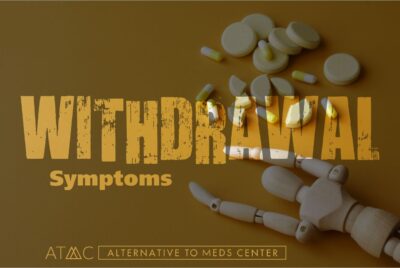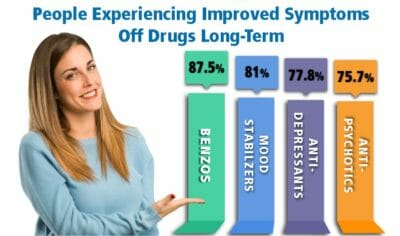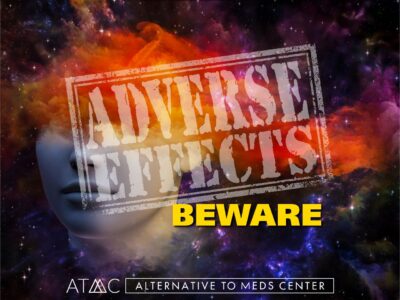Last Updated on November 21, 2023 by
Alternative to Meds Editorial Team
Medically Reviewed by Dr Michael Loes MD
Last Updated on November 21, 2023 by
Alternative to Meds Editorial Team
Medically Reviewed by Dr Michael Loes MD
Valium withdrawal, and generally, withdrawals from all benzodiazepines can occur within one to four days after stopping. Dependence can develop after even short-term use; hence, the minimum dose and minimum duration of use are recommended. Stopping Valium© abruptly can greatly intensify withdrawal symptoms, which may continue for years after stopping.3,12,19-21,29
This is especially apparent after long-term use, and sometimes protracted Valium withdrawal symptoms may last for a very long time without proper treatment.9,40,41
 seizures (can be life-threatening)
seizures (can be life-threatening)*While there is no cookie-cutter timeline for all persons undergoing diazepam withdrawal, researchers Brett and Murnion advise at least 10 weeks for gradual Valium withdrawal. 12
Benzodiazepines like Valium cannot be seen through the same lens as other drug withdrawals. The professionals managing the process should do so strategically and compassionately.

Valium is a sedative in the benzodiazepine class that is used in the short-term treatment of mild to moderate anxiety. Off-label uses include insomnia, restless legs syndrome, and to prevent seizures during acute alcohol detox.24,37 Valium is also used off-label to relieve secondary injury-related muscle spasms and for short-term treatment of spasticity in children with cerebral palsy.30 Valium is also used off-label as pre-surgical or post-surgical sedation. In addition to pill form, it can be delivered intravenously in liquid suspension. When taken for short periods, Valium withdrawal may be much milder, but even in these cases, symptoms can be surprisingly challenging.
Day-to-day stress or anxiety are not valid indications for a benzodiazepine prescription, according to the FDA Valium drug label, yet there is much evidence of such. In 2021 a study in the Cureus Journal was published outlining the continuing rise of the use and abuse of benzodiazepines. From 1996 to 2013 benzodiazepine use accelerated by 67%. Off-label uses include a dizzying number, all without formal approval by regulators.33-35 This trend has continued since then, with another spike over the duration of the recent global pandemic.
Benzodiazepine drugs have been the main strategy for the treatment of insomnia and anxiety during the pandemic. Authors of a study on this recent trend call it an epidemic within a pandemic. Valium has been the main drug used during the pandemic to address these and other consequences attributed to the stress of lockdowns all around the world, including increases in domestic violence, psychological distress, substance abuse, and social isolation.32
There are also some newer versions, such as diazepam nasal spray and rectal gel.28 Like all benzodiazepines, Valium loses efficacy over time (tolerance) and should not be prescribed long-term. Regardless of the version of the drug, our best understanding of benzodiazepines clearly shows that Valium withdrawals deserve medical guidance for both safety and comfort.3,13,24,30
*Valium is a Class IV drug, intended for short-term use only, at the minimum dose required as advised on the FDA-approved drug label. Research suggests that the harshness of Valium withdrawal and adverse effects may be from long-term use causing neuronal damage.8
Diazepam is the generic name for the active drug in Valium. Other trade names exist, including Diastat Acudial©, Diastat©, and Diazepam Intensol©.
Today, Valium has developed a significant street presence, possibly due to, at least in part, Valium’s cheap cost, fast, profound calming effects, and near-immediate effects for easing withdrawals from other addictive drugs such as opiates. Of some great concern, fraudulent or counterfeit drugs may be sold as “street valium”, which can be poisonous or even lethal.6,7
Slang names for drugs are useful when people want to hide or even trivialize what they are actually talking about for social, legal, or other reasons. According to Johnson and Streltzer’s editorial in the Journal of the American Physician, many of the 4 million benzodiazepine users in the US are unprescribed users who have developed an addiction to these drugs.9,13
Slang or substitute names that refer to Valium sold illicitly are:

Reportedly, Valium is associated with a great many adverse reactions, as described in the APA National Center for Biotechnology Information.13 From the APA summary, and from the FDA drug label for Valium, we have grouped some of the most important ones to be aware of below for the sake of brevity.
CNS Depression:
Disorders:
Paradoxical Effects
To note, this is not a complete list of potential paradoxical effects. If any symptoms arise that seem unusual or are of concern, contact your prescribing physician without delay. Additionally, you can also report any adverse reactions to Valium or any medication by calling 1 800 FDA-1088, a voluntary reporting hotline.
Cautions and Risks Associated With Benzodiazepines 3,9,10,13,19
You can find below some of the most frequently asked questions about diazepam and benzodiazepines in general. The information provided includes the theorized mechanics of action, a description of overdose symptoms, and other relevant topics.
Benzodiazepines have been linked to thousands of overdose deaths, and yet remain one of the most commonly prescribed drugs in the country.
There are many reasons why a person would begin taking a benzodiazepine, just as there can be many symptoms that drugs are used to suppress.
At Alternative to Meds Center, this gives us two major areas of expertise:

Especially where Valium was used for a long time, protocols such as neurotoxin removal and neurotransmitter are key to help reduce drug effects like cognitive dysfunction that may otherwise continue to linger.38
While all drugs can be problematic to get off easily, benzodiazepines such as Valium are famously difficult. However, our Benzo withdrawal program has become one of our most popular and requested services, routinely delivering a safe, comfortable Valium withdrawal experience.
Do you want to address the symptoms you thought Valium would solve — but did not? Alternative to Meds Center’s aim is to address these issues in holistic ways to attain long-term relief. Such holistic therapy does not create more chaos or contribute to further decline. The goal is to alleviate unwanted symptoms without drugs. The entire breadth of treatments the center offers cannot really be fully described in a short article. But, you can find a summary of therapies and methods on our benzodiazepine alternatives and services overview pages.
We have been helping people with Valium withdrawal and holistic recovery for nearly 2 decades with great success. Please take the time to review our information, and feel free to discuss these alternative treatment options with your prescribing physician. Or call us for direct information or for other questions you may have about insurance coverage or other topics of interest regarding inpatient treatment at our beautiful facility in Sedona Arizona.
You can find relief. We can help. Contact us for more information about our Valium withdrawal programs, founded on holistic principles, that can help in achieving sustainable and natural, vibrant mental health.
1. Bachhuber MA MD MSHP, Hennessy S PharmD PhD, Cunningham CO MD MS, Starrels JL MD MS “Increasing Benzodiazepine Prescriptions and Overdose Mortality in the United States, 1996–2013” American Journal of Public Health, 2016 Apr [cited 2022 Aug 9]
2. Davison K, Farquharson RG, Khan MC, Majid A. A double blind comparison of alprazolam, diazepam and placebo in the treatment of anxious out-patients. Psychopharmacology (Berl). 1983;80(4):308-10. doi: 10.1007/BF00432110. PMID: 6137856. [cited 2022 Aug 9]
3. FDA drug label Valium (diazepam) [approved 1963, revised 2016] [cited 2022 Aug 9]
4. Santo L et al., “Physician Office Visits At Which Benzodiazepines Were Prescribed: Findings from 2014-2016 National Ambulatory Medical Care Survey” CDC NSHR Report #137 Published January 2017 [cited 2022 Aug 9]
5. Perry S, “Neurotransmitters: How Brain Cells Use Chemicals to Communicate.” Brainfacts.org 2011 May 16 [cited 2022 Aug 9]
6. Lung DD, Gerona RR, Wu AH, Smollin CG. Confirmed glyburide poisoning from ingestion of “street Valium”. J Emerg Med. 2012 Aug;43(2):276-8. doi: 10.1016/j.jemermed.2011.06.019. Epub 2011 Oct 5. PMID: 21978878. [cited 2022 Aug 9]
7. Nayyar GML, Attaran A, Clark JP, et al. Responding to the pandemic of falsified medicines. Am J Trop Med Hyg. 2015;92(6 Suppl):113-118. doi:10.4269/ajtmh.14-0393 [cited 2022 Aug 9]
8. Ashton H. Protracted withdrawal syndromes from benzodiazepines. J Subst Abuse Treat. 1991;8(1-2):19-28. doi: 10.1016/0740-5472(91)90023-4. PMID: 1675688. [cited 2022 Aug 9]
9. Johnson B, Streltzer J, “Risks Associated with Long-term Benzodiazepine Use.” American Family Physician Journal Editorial 2013 Aug 15;88(4):224-225. [cited 2022 Aug 9]
10. Movig KL, et al. Psychoactive substance use and the risk of motor vehicle accidents. Accid Anal Prev. 2004;36(4):631–636.[cited 2022 Aug 9]
11. Olfson M, King M, Schoenbaum M. Benzodiazepine Use in the United States. JAMA Psychiatry. 2015;72(2):136–142. doi:10.1001/jamapsychiatry.2014.1763 [cited 2022 Aug 9]
12. Brett J, Murnion B. Management of benzodiazepine misuse and dependence. Aust Prescr. 2015;38(5):152-155. doi:10.18773/austprescr.2015.055 [cited 2022 Aug 9]
13. National Center for Biotechnology Information (2021). PubChem Compound Summary for CID 3016, Diazepam. [cited 2022 Aug 9]
14. Stübner S, Grohmann R, Engel R, Bandelow B, Ludwig WD, Wagner G, Müller-Oerlinghausen B, Möller HJ, Hippius H, Rüther E. Blood dyscrasias induced by psychotropic drugs. Pharmacopsychiatry. 2004 Mar;37 Suppl 1:S70-8. doi: 10.1055/s-2004-815513. PMID: 15052517. [cited 2022 Aug 9]
15. Suetrong B, Walley KR. Lactic Acidosis in Sepsis: It’s Not All Anaerobic: Implications for Diagnosis and Management. Chest. 2016 Jan;149(1):252-61. doi: 10.1378/chest.15-1703. Epub 2016 Jan 6. PMID: 26378980. [cited 2022 Aug 9]
16. Moore CA, Krishnan K. Aplastic Anemia. [Updated 2020 Nov 23]. In: StatPearls.Treasure Island (FL): StatPearls Publishing; 2021 Jan-. [cited 2022 Aug 9]
17. Adeyinka A, Kondamudi NP. Cyanosis. [Updated 2021 Feb 26]. In: StatPearls [Internet]. Treasure Island (FL): StatPearls Publishing; 2021 Jan-. [cited 2022 Aug 9]
18. Khazaeni B, Khazaeni L. Acute Closed Angle Glaucoma. 2021 Jan 12. In: StatPearls [Internet]. Treasure Island (FL): StatPearls Publishing; 2021 Jan–. PMID: 28613607. [cited 2022 Aug 9]
19. Mancuso CE, Tanzi MG, Gabay M. Paradoxical reactions to benzodiazepines: literature review and treatment options. Pharmacotherapy. 2004 Sep;24(9):1177-85. doi: 10.1592/phco.24.13.1177.38089. PMID: 15460178. [cited 2022 Aug 9]
20. Coey JG, De Jesus O. Hyperacusis. [Updated 2021 Apr 12]. In: StatPearls [Internet]. Treasure Island (FL): StatPearls Publishing; 2021 Jan-. Available from: https://www.ncbi.nlm.nih.gov/books/NBK557713/ [cited 2022 Aug 9]
21. Phillips ML, Medford N, Senior C, Bullmore ET, Suckling J, Brammer MJ, Andrew C, Sierra M, Williams SC, David AS. Depersonalization disorder: thinking without feeling. Psychiatry Res. 2001 Dec 30;108(3):145-60. doi: 10.1016/s0925-4927(01)00119-6. PMID: 11756013. [cited 2022 Aug 9]
22. Barten HH. TOXIC PSYCHOSIS WITH TRANSIENT DYSMNESTIC SYNDROME FOLLOWING WITHDRAWAL FROM VALIUM. Am J Psychiatry. 1965 Jun;121:1210-1. doi: 10.1176/ajp.121.12.1210. PMID: 14286060. [cited 2022 Aug 9]
23. Löscher W, Schmidt D. Diazepam increases gamma-aminobutyric acid in human cerebrospinal fluid. J Neurochem. 1987 Jul;49(1):152-7. doi: 10.1111/j.1471-4159.1987.tb03407.x. PMID: 3585326. [cited 2022 Aug 9]
24. Calcaterra NE, Barrow JC. Classics in chemical neuroscience: diazepam (valium). ACS Chem Neurosci. 2014;5(4):253-260. doi:10.1021/cn5000056 [cited 2022 Aug 9]
25. Noyes R Jr, Perry PJ, Crowe RR, Coryell WH, Clancy J, Yamada T, Gabel J. Seizures following the withdrawal of alprazolam. J Nerv Ment Dis. 1986 Jan;174(1):50-2. doi: 10.1097/00005053-198601000-00009. PMID: 2867122. [cited 2022 Aug 9]
26. United States Drug Enforcement Information Bulletin, “Drug Scheduling” [18 November 2021] [cited 2022 Aug 9]
27. Greenblatt D, Harmatz J, Zhang Q, Chen Y, Shader R, “Slow Accumulation and Elimination of Diazepam and its Active Metabolite With Extended Treatment in the Elderly.” Journal of Clinical Pharmacology [27 August 2020] [cited 2022 Aug 9]
28. Hogan RE, Gidal BE, Koplowitz B, Koplowitz LP, Lowenthal RE, Carrazana E. Bioavailability and safety of diazepam intranasal solution compared to oral and rectal diazepam in healthy volunteers. Epilepsia. 2020 Mar;61(3):455-464. doi: 10.1111/epi.16449. Epub 2020 Feb 17. PMID: 32065672; PMCID: PMC7154760. [cited 2022 Aug 9]
29. Reidenberg MM, Levy M, Warner H, Coutinho CB, Schwartz MA, Yu G, Cheripko J. Relationship between diazepam dose, plasma level, age, and central nervous system depression. Clin Pharmacol Ther. 1978 Apr;23(4):371-4. doi: 10.1002/cpt1978234371. PMID: 630787. [cited 2022 Aug 9]
30. Dhaliwal JS, Rosani A, Saadabadi A. Diazepam. [Updated 2021 Sep 14]. In: StatPearls [Internet]. Treasure Island (FL): StatPearls Publishing; 2022 Jan-. Available from: https://www.ncbi.nlm.nih.gov/books/NBK537022/ [cited 2023 May 11]
31. Lopez MJ, Tadi P. Drug Enforcement Administration Drug Scheduling. 2021 Aug 19. In: StatPearls Treasure Island (FL): StatPearls Publishing; 2022 Jan–. PMID: 32491358. [cited 2023 May 11]
32. Sarangi A, McMahon T, Gude J. Benzodiazepine Misuse: An Epidemic Within a Pandemic. Cureus. 2021;13(6):e15816. Published 2021 Jun 21. doi:10.7759/cureus.15816 [cited 2023 May 11]
33. Calcaterra NE, Barrow JC. Classics in chemical neuroscience: diazepam (valium). ACS Chem Neurosci. 2014;5(4):253-260. doi:10.1021/cn5000056 [cited 2023 May 11]
34. The Alliance for Benzodiazepine Best Practices, On and Off Label Uses [published online 2020] [cited 2023 May 11]
35. Kripke DF. Greater incidence of depression with hypnotic use than with placebo. BMC Psychiatry. 2007;7:42. Published 2007 Aug 21. doi:10.1186/1471-244X-7-42 [cited 2023 May 11]
36. Senninger JL, Laxenaire M. Réactions paradoxales de violence secondaires à la prise de benzodiazépines [Violent paradoxal reactions secondary to the use of benzodiazepines]. Ann Med Psychol (Paris). 1995 Apr;153(4):278-81; discussion 281-2. French. PMID: 7618826. [cited 2023 May 11]
37. Calcaterra NE, Barrow JC. Classics in chemical neuroscience: diazepam (valium). ACS Chem Neurosci. 2014;5(4):253-260. doi:10.1021/cn5000056 [cited 2023 May 11]
38. Golombok S, Moodley P, Lader M. Cognitive impairment in long-term benzodiazepine users. Psychol Med. 1988 May;18(2):365-74. doi: 10.1017/s0033291700007911. PMID: 2899898. [cited 2023 May 11]
39. Papp A, Onton JA. Brain Zaps: An Underappreciated Symptom of Antidepressant Discontinuation. Prim Care Companion CNS Disord. 2018 Dec 20;20(6):18m02311. doi: 10.4088/PCC.18m02311. PMID: 30605268. [cited 2023 July 29]
40. Schweizer E, Rickels K, Case WG, Greenblatt DJ. Long-term therapeutic use of benzodiazepines. II. Effects of gradual taper. Arch Gen Psychiatry. 1990 Oct;47(10):908-15. doi: 10.1001/archpsyc.1990.01810220024003. PMID: 2222130. [cited 2023 July 29]
41. Ashoton Manual Chapter 3: Benzodiazepine withdrawals published byu the Benzodiazepine Information Coalition [cited 2023 July 29]
Originally Published Sep 13, 2018 by Diane Ridaeus

Dr. Michael Loes is board-certified in Internal Medicine, Pain Management and Addiction Medicine. He holds a dual license in Homeopathic and Integrative Medicine. He obtained his medical doctorate at the University of Minnesota, Minneapolis, MN, 1978. Dr. Loes performed an externship at the National Institute of Health for Psychopharmacology. Additionally, he is a well-published author including Arthritis: The Doctor’s Cure, The Aspirin Alternative, The Healing Response, and Spirit Driven Health: The Psalmist’s Guide for Recovery. He has been awarded the Minnesota Medical Foundation’s “Excellence in Research” Award.

Diane is an avid supporter and researcher of natural mental health strategies. Diane received her medical writing and science communication certification through Stanford University and has published over 3 million words on the topics of holistic health, addiction, recovery, and alternative medicine. She has proudly worked with the Alternative to Meds Center since its inception and is grateful for the opportunity to help the founding members develop this world-class center that has helped so many thousands regain natural mental health.

Can you imagine being free from medications, addictive drugs, and alcohol? This is our goal and we are proving it is possible every day!
Read All StoriesView All Videos